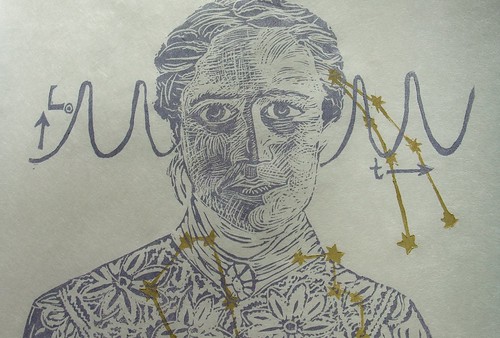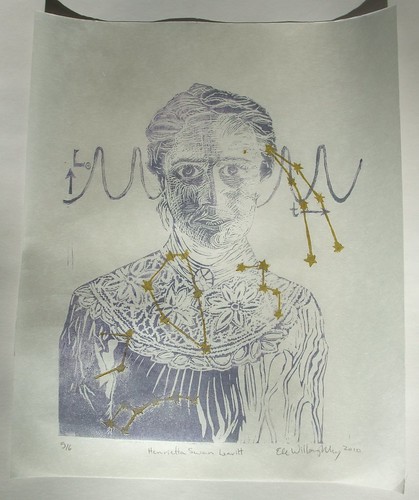
This is a first edition lino block print of the woman who was able to set the scale of our Universe. A portrait of Henrietta Swan Leavitt is printed in silvery lavender ink on Japanese kozo (or mulberry paper). Behind her is a line showing stellar luminosity (capital L with subscript sun-symbol, a circle with a dot) as a function of time (t). She is printed over constellations in gold (Cepheus, Cassiopeia, Draco, Ursa Minor and Andromeda). The first edition is a run of 6 prints, each 10" by 12.5" (25.4 cm by 31.8 cm).

Henrietta Swan Leavitt (July 4, 1868 – December 12, 1921) was an American astronomer. In her day, women scientists were regularly hired to do menial chores. She was hired to count images on photographic plates as a "computer".* In studying these plates, in 1908 she was able to deduce a ground-breaking theory, which allowed Hubble's later insight about the age and expansion of the universe**. Her period-luminosity relation for Cepheid variable stars radically changed modern astronomy, an accomplishment for which she received little recognition during her lifetime.
Cepheid variables are a class of pulsating star. They are named for the star Delta Cephei in the Cepheus constellation. The relationship between a Cepheid variable's luminosity and pulsation period is quite precise. It had not been obvious to tell whether a star was dim because it was less luminous, or whether it was merely further away. Swan Leavitt's discovery lets astronomers use Cepheids as "standard candles". They allow astronomers to determine distances to celestial objects and form the foundation of the Extragalactic Distance Scale.

This April, the Mad Scientists of Etsy are celebrating Henrietta Swan Leavitt, who died too young, but accomplished more than most and greatly added to our understanding of our place in the Universe.
Also, she's a serious contender to battle Annie Jump Cannon for "best astronomer middle name".

*These "computers" were quite literally treated like automatons.
**Ejnar Hertzsprung used her discovery to plot the distance of stars; Harlow Shapley used it to measure the size of the Milky Way; and Edwin Hubble used her work to ascertain the age of the Universe.









No comments:
Post a Comment